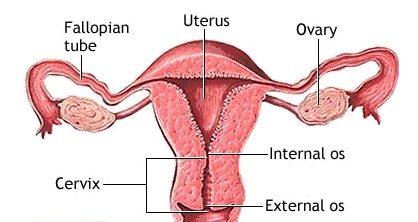The opening to the uterus is called the “cervix”. It is situated at the top of the vagina and takes on different positions depending on whether you are having period, ovulating or pregnant. Along with a blood or urine test, doctor can check cervical position to actually find out if you have conceived. This is because when you are not pregnant, your cervix is long and firm. After conception, it becomes higher and softer. As you go through pregnancy, it thins out and stretches to get ready for childbirth. While you may think checking cervical position is only something doctors do in the office, actually you can learn how to do it by yourself and know your body better.

Cervical Position in Early Pregnancy
Cervical Position After Your Period
After your period has finished the cervix drops very low in the vaginal canal. It closes up and hardens like the tip of your nose. This is believed to be the least fertile period in your cycle.
Cervical Position During Ovulation
Mid cycle and just prior to ovulation, estrogen raises and tells the cervix to come up higher in the vagina. It softens and opens just a little.
During this period you are most fertile and should be having sex every other day if you are trying to conceive. If you are not trying to conceive and are not using protection, try to avoid sex during this time.
Cervical Position in Early Pregnancy
After conception, the cervix will stay soft and high in the vagina. However, the opening closes tightly and your body forms a mucus plug to seal up the uterus during pregnancy. This may happen within a few hours to up to a month after conception.
Cervical Position in Early Pregnancy Can Be Deceiving
The above mentioned cervical position changes can only be a sign of pregnancy. They may not be accurate and can't be a confirmation that you are pregnant because the changes may occur either sooner or later in some women.
The only way to confirm a pregnancy is with a blood test and heartbeat on ultrasound. doctors only use cervical position as one of the many signs that a woman is pregnant, but ultimately seeing a heartbeat is definite confirmation.
Cervical Position Before Labor
The cervix when pregnant closes up and forms a mucus plug to protect the baby. It remains firm and long and points toward your back. When you begin labor, the cervix begins to ripen and open up. It also gets shorter, points to the front of your body and softens, feeling like the lip tissue.
How to Check Cervical Position
Wash Your Hands
Make sure you wash your hands thoroughly first. This is to prevent bacteria and other germs from getting near your cervix, which could cause an infection. If you already have an infection that you know of, don’t check your cervix until the infection is healed.
Get into a Comfortable Position
You will want to get into a position that get your cervix as low in the vagina as possible. This is usually squatting, sitting on the toilet or put one of your legs up on the edge of the bathtub.
Know Where You Are Going
Before you go in you should know where to reach. Your vagina is like a long hall with your cervix sitting at the other end. The walls of your vagina will be soft. But when you reach the cervix, it will feel kind of like the tip of your nose.
Place Your Finger Inside
Slide your longest finger all the way up as far as you can reach. You may have to move your finger towards the front and back once at the top to find it. Make sure you don’t scratch yourself with your nails.
If you are having trouble reaching your cervix which is very high and closed, this is a possible sign of pregnancy. You will need to see your doctor for confirmation testing.
- If you are using cervical position for fertility reasons, keep a journal of what your cervix feels like at different times in your cycle. This will help you identify ovulation better or know if you might be pregnant by any unusual changes.
- The first few times you check your cervix, you may not feel comfortable or even don't know what you are supposed to feel. This is okay and be patient. Over time you will know your body better. If you practice this over 6 times, you will quickly understand changes and meaning of cervical positions.

View All Comments /Add Comment